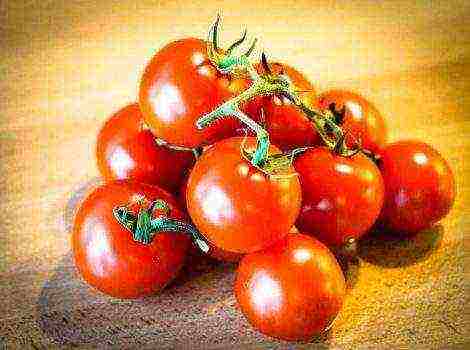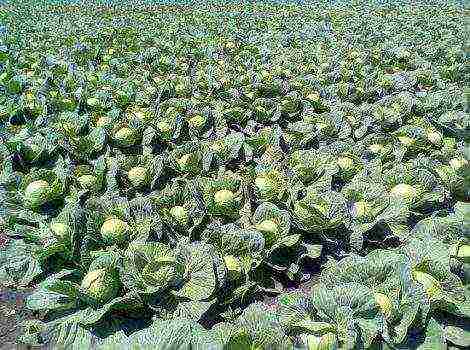Content
- 1 Cherry varieties: description and photo
- 2 Cherry varieties: classifications
- 3 Description of cherry varieties with photos
- 3.1 Drogan yellow cherry variety
- 3.2 Cherry variety Home Garden Yellow
- 3.3 Cherry variety Rechitsa
- 3.4 Cherry variety Leningradskaya Black
- 3.5 Cherry variety Ovstuzhenka
- 3.6 Cherry variety Leningradskaya pink
- 3.7 Cherry variety Tyutchevka
- 3.8 Cherry varieties Revna
- 3.9 Sweet cherry varieties Iput
- 3.10 Sweet cherry varieties Fatezh
- 3.11 Sweet cherry varieties Bryansk pink
- 4 What to consider when choosing a cherry variety?
- 5 The best varieties
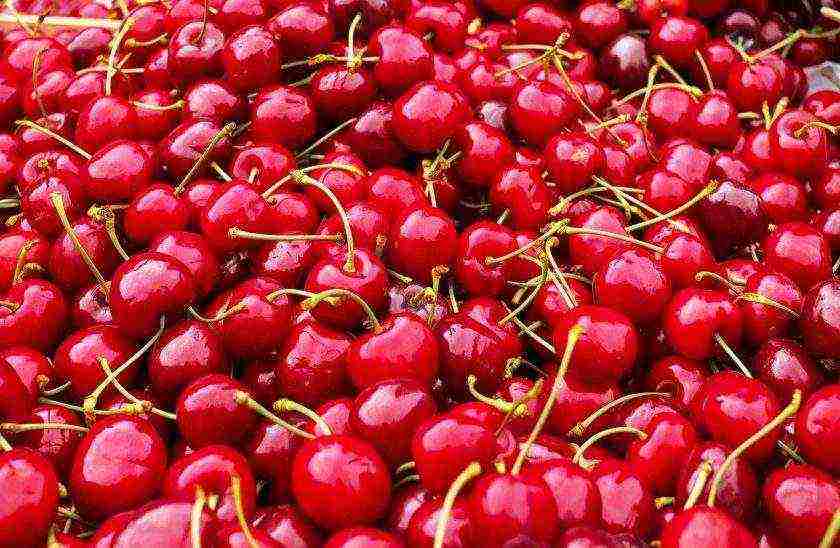
Let's talk about cherries and describe the best varieties of it. There are sweet, slightly sour, crispy, soft, different colors. Thanks to selection, every year new forms of this amazing tree are bred.
Cherry varieties: description and photo

To get a bountiful harvest, it is necessary to choose varieties taking into account the peculiarities of the climate in a particular region. So, frost-resistant varieties are suitable for central Russia, and more thermophilic plants can be grown in Ukraine.
Unlike cherry, sweet cherry ripens much earlier, its tasty and aromatic fruits can already be enjoyed in early summer - June. It is a real source of useful trace elements (iron, iodine, potassium, magnesium, calcium) The fruits of the plant grow in the form of a single-celled drupe with a juicy pericarp.
Taking into account the late period of emergence of cherry fruit buds from the state of forced dormancy, the yield of this crop is characterized as stable. Another advantage of cherries is the presence of reliable protection from return frost in anthers and pistils, which is not the case with cherries.
The leaves of the fruit crop are very large in size, they are distinguished by an elongated-oval or elongated-obovate shape and brown glands on the petioles.
Most of the cherry varieties require additional pollination. Therefore, when choosing a tree, it is recommended to study its description, which indicates the necessary pollinators.
It is not so often possible to find self-fertile varieties on the market. They can be purchased by order from abroad. Among the popular hybrid forms, there are: Alex, Peter, Stella, Sandor, Sweet Hart.
Below is a list of the most popular cherry varieties with descriptions and photos.
Iput
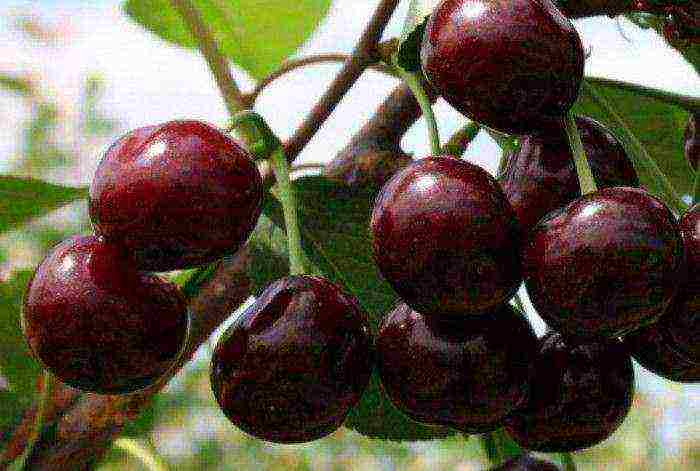
Read also:Everything about planting and growing cherries - from choosing a seedling to harvesting (Photo & Video) + Reviews
PROS:
- Average height
- Early ripening of fruits
- High yield (up to 30 kg of berries are removed from one tree)
- High palatability (fruits have black color and dark red juicy pulp)
- The berry is removed with the stalk
- The crop is not afraid of transportation
- High degree of resistance to fungal infections
- It tolerates low temperatures well (up to -28 degrees)
MINUSES:
- Average early maturity (yields a harvest 5 years after planting)
- With an excess of moisture, the fruits crack
- The pulp is difficult to separate from the bone
According to reviews:
It is recommended to plant it in pairs together with Revna, since these varieties are inter-pollinated. It turned out to be very tasty, large, the first harvest is already 3 years old. It grows quickly, almost one-meter increments per year. turned out to be not dark red, but just red, maybe because of the lack of the sun.
Valery Chkalov

PROS:
- Early ripening of berries
- Large fruit size (weight up to 6-8 g)
- High taste characteristics of the fruit (the pulp is dark red in color, juicy, semi-gristly consistency)
- Dessert type
- Universal use of berries
- High level of productivity (62 kg per tree on average)
- High level of frost resistance (-23.5 degrees
MINUSES:
- Height (up to 5 m)
- Wet separation of the berry from the stalk, juice is released
- The level of early maturity is medium (yields a harvest for 5 years)
- Self-infertile variety
- Average level of resistance to diseases, including fungal
Pollinators: Dnieper, Bigarro Burlat, April, June early Skorospelka
Jealous
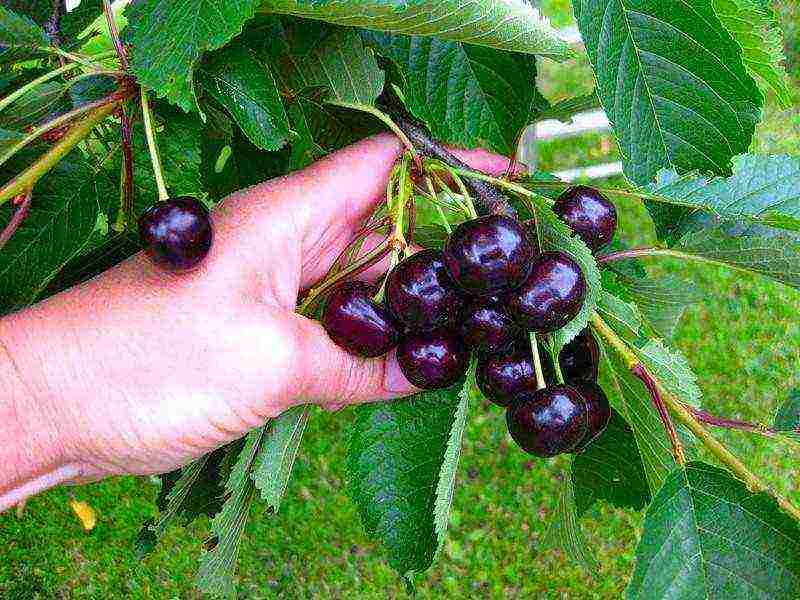
Read also:Cherries: what you need to know about them in order to get generous harvests. Description, planting and care (25 Photos & Videos) + Reviews
PROS:
- Medium-sized tree, compact
- The crown has no sharp forks
- Unpretentious in care
- Fruits are distinguished by high taste and consumer qualities.
- Due to the dense skin, the crop is transportable over long distances
- High level of frost resistance (up to -30 degrees)
- High resistance to frost crack, sunburn
- Resistance of the tree to fungal infections
MINUSES:
- Medium late harvest ripening
- Self-infertility
Its best pollinators: Raditsy, Compact, Iput, Venyaminova, Tyutchevka, Ovstuzhenki
Large-fruited

PROS:
- Medium-sized tree
- Fruits are very large in size, their weight is up to 18 g
- Sweet and sour taste, dark red fruit color, medium density pulp
- High product characteristics
- Increased frost resistance
- Dry detachment of the peduncle
- Good transportability
- Not susceptible to moniliosis
- Drought tolerance, no loss of crop flavor
MINUSES:
- Late ripening
- Self-sterile
Top pollinators: Bugaro Oratovsky, Surprise, Francis,
Vasilisa
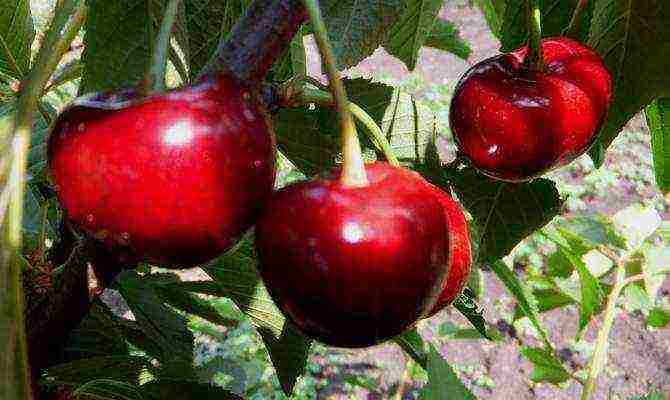
PROS:
- Mid-season
- Very large berries, weighing up to 15 g
- Taste and commercial qualities are excellent (the fruits have a rich red color, glossy shine, the pulp is dense, fleshy, juicy)
- Tasting score 4.5 points
- Duration of fruiting 20 years
MINUSES:
- Berries with heavy precipitation are subject to shedding
- Requires additional pollination
- Low resistance to fungal diseases and garden pests
Top pollinators: Early ripening, Burlat, April, Household, Early Bigarro
Ovstuzhenka

PROS:
- Early ripening of the crop
- It does not require special care
- Medium-sized tree, with a rapid growth rate
- Large berries, weight up to 7 g
- The pulp is sweet enough, juicy
- The color of the berries is dark burgundy
- Product and taste characteristics are high
- Disease resistance is good
- High frost resistance
MINUSES:
- Average yield, on average 15 kg per tree
Regina
PROS:
- Late-ripening variety
- The size of the tree is medium, the growth is gradual
- Does not create difficulties in care and harvesting
- High indicator of presentation and taste
- Berries are not afraid of transportation
- The structure of the berries is firm, the pulp is tasty and aromatic
- The size of the fruits is large, their weight reaches 10 g
- The level of frost resistance is sufficient
- Disease resistance to garden pests is excellent
MINUSES:
- Low rate of resistance to viral diseases
- Requires additional pollination
Pollinators: Karina, Bianca, Sylvia, Nephris, Coral Lotivka
Bull heart

PROS:
- Large-fruited, average berry size 8 g
- The color of the fruit is dark burgundy, the pulp is of medium density, the skin is moderately dense with a smooth surface
- Type of separation from the stalk dry
- Universal purpose of fruits
- High degree of productivity
- The size of the tree is medium, but there are also tall plants.
- The degree of frost resistance is good, up to - 25 degrees
- Not susceptible to coccomycosis
MINUSES:
- Low transport rate despite dense skin
- Berries have a short shelf life, processing is required as soon as possible
- Self-infertile variety
Top pollinators: Tyutchevka, Iput, Ovstuzhenka
Yellow

PROS:
- Late ripening of berries
- Increased winter hardiness
- Excellent taste (the pulp is amber, dense structure, juiciness and pronounced aroma)
MINUSES:
- The degree of transportability is low
- The pulp does not separate well from the bone
- Additional pollination required
- Exposed to the invasion of the cherry fly
Pollinators: Bagration, Napoleon pink. Denissena yellow, Cassini early
Early pink
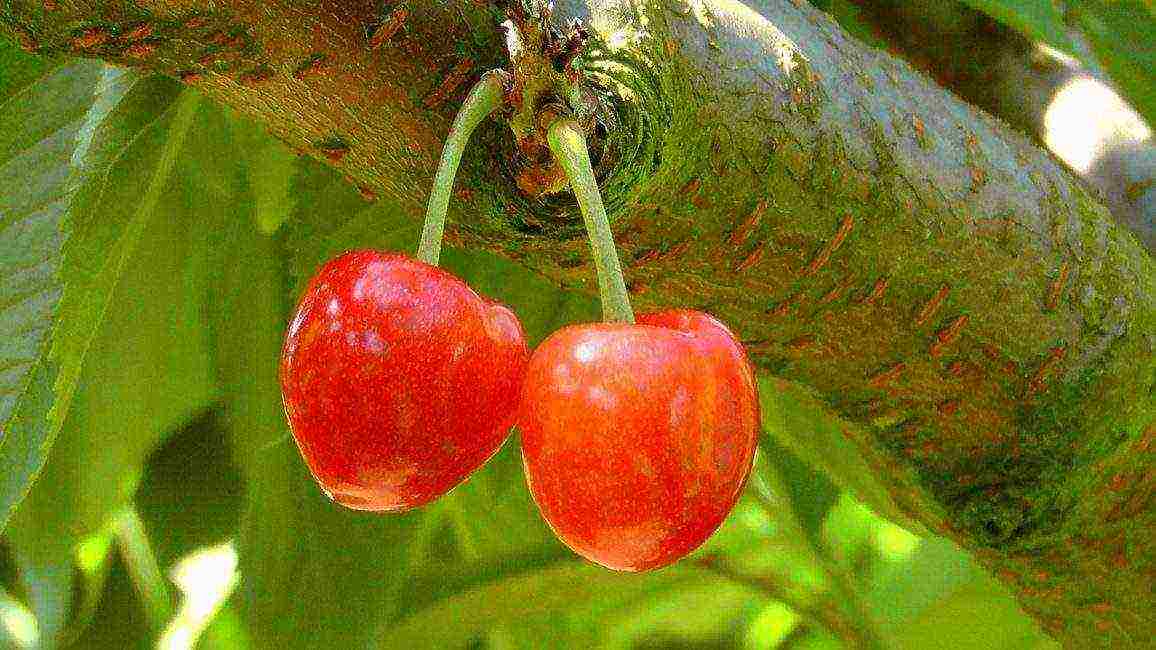
PROS:
- Early ripeness of fruits
- Taste characteristics are high (the pulp is distinguished by a creamy color, the structure is medium-dense, the juice is transparent)
- High resistance to low temperatures
- A fairly good level of resistance to monoliosis, coccomycosis
- Dessert type of berries
- High yield rate, up to 40 kg per tree on average
MINUSES:
- Berries are medium in size, their weight reaches an average of 5 g
- Trees grow up to 5 m
- Low rate of crop transportability
- Poor keeping quality of berries, processing is required in a short time after full ripening
Fatezh
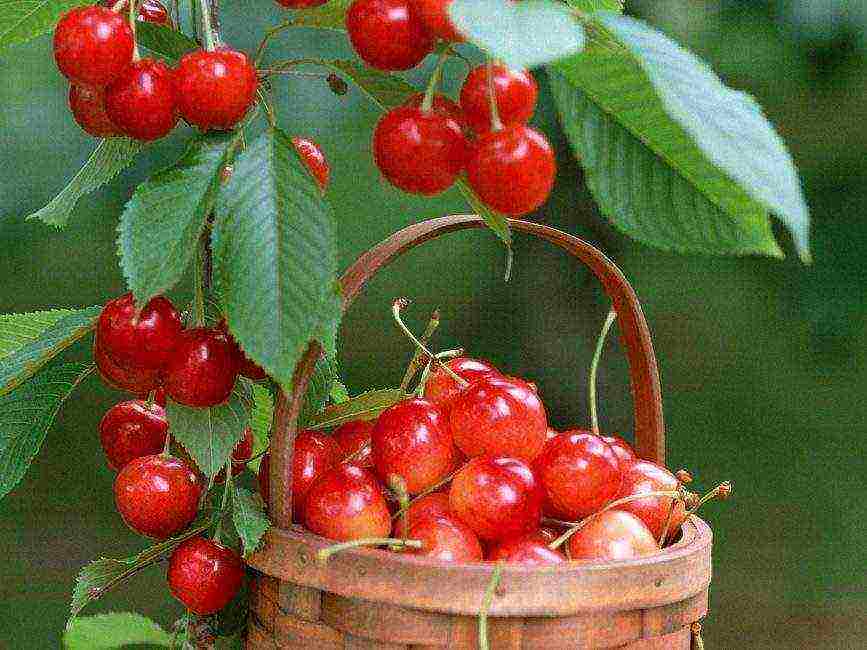
PROS:
- Large-fruited, their average weight is 4.5 g, maximum 6 g
- Fruit tasting score 4.7 points
- The pulp separates easily from the bone
- Fruiting begins at 3-4 years of life of the tree
- The yield indicator reaches 50 kg per tree per season
- The level of winter hardiness is high -30 degrees
- Not susceptible to fungal infections, coccomycosis, moniliosis
- Berries are not afraid of long distance transportation
MINUSES:
- Additional pollination required
Recommended pollinators: Chermashnaya, Iput, Revna, Crimean, Raditsa.
Leningrad black
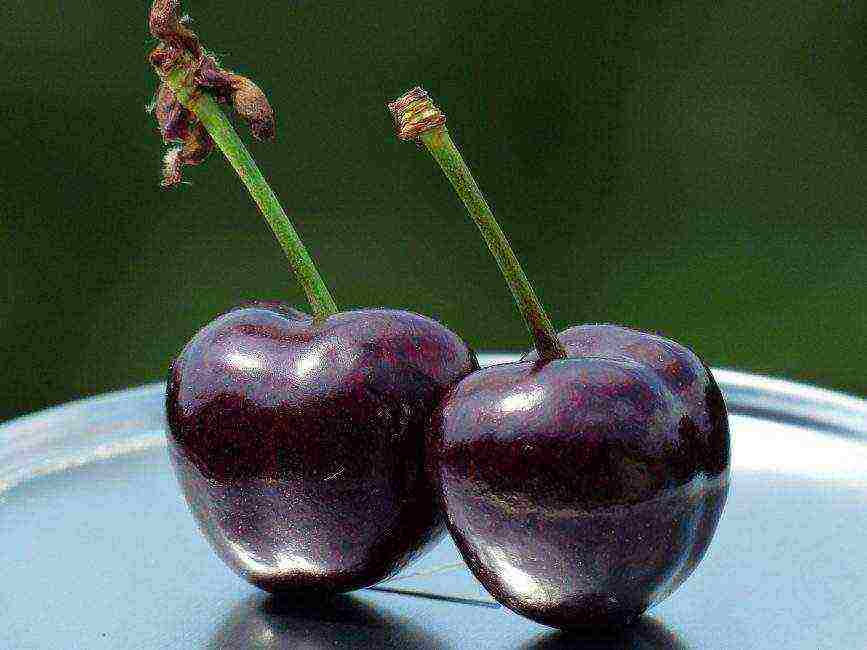
PROS:
- The variety is medium-sized, the crown is spreading
- The first crop can be harvested in the third year after planting in a permanent place, in June
- Tasting assessment of the harvest 4.2 points
- The taste and market characteristics are high (the average weight of berries is 5 g, the color is dark burgundy, the pulp is sweet, juicy, there is a slight bitterness)
- The purpose of the fruit is universal, excellent for fresh consumption, and for compotes, jam
- High rate of resistance to garden pests and various diseases
- The variety is unpretentious in care
- The increased degree of frost resistance, withstands low temperatures up to -30 degrees
MINUSES:
- Self-fertile variety
- Additional pollination required
Pollinators required: Leningrad yellow, Leningrad pink, Red dense, Fatezh Berries are prone to cracking, with excessive moisture.
Dybera black
PROS:
- High level of productivity, most often up to 90 kg of tasty and aromatic berries are removed from trees, but under favorable conditions, 170 kg of harvest can be removed from one tree
- Fruits are large in size, their average weight is 6 g
- The pulp is of medium density, juiciness, dark burgundy color, there is a slight sourness
- The frost resistance index is quite high, up to -30 degrees
MINUSES:
- Poor resistance to negative temperatures
- Mature trees reach a height of almost 6 m, which makes them difficult to care for and harvest
- The tree begins to bear fruit 5 years after planting in a permanent place
- Requires additional pollination
- Insufficient immunity to various types of diseases, including fungal, to garden pests
- Regular pruning of the crown is required
Recommended pollinators: Drogana yellow, Bull heart, Napoleon pink, Fatezh,
Cordia
PROS:
- "Queen" of late varieties
- Universal fruits
- Taste and commercial characteristics are high
- Berries are large enough, their weight can reach 8-10 g
- Color carmine black, skin tone bronze
- Fruits are not prone to cracking, do not rot
- Excellent long-distance transportation
- When grown on vigorous rootstocks, it grows rapidly
- Productivity is regular, fairly high
MINUSES:
- The variety is self-fertile, additional pollination is required
- There is a need for short pruning, the growth of shoots is significantly enhanced
- Average winter hardiness
- The crop is moderately resistant to cracking
Top pollinators: Van, Summit, Karina, Regina, Burlat.
Tyutchevka
PROS:
- Medium late harvest ripening
- Medium-sized tree, semi-spreading crown, sparse, spherical
- The beginning of the fruiting period falls on 3-4 years of plant life.
- The berries are medium in size, their weight is 5-6 g, but under favorable growing conditions they can reach 7 g
- Taste and commercial characteristics are excellent (the color of the pulp is dark red, the structure is dense, the aroma is pronounced)
- Tasting assessment of the harvest 4.9 points
- The crop is not afraid of transportation over long distances, the keeping quality of the fruits is good
- Resistance to major diseases is good
- The average productivity index is over 97 c / ha, with proper agricultural technology this indicator can reach 275 c / ha
- High level of resistance to moniliosis
MINUSES:
- Low self-pollination rate, up to 6%
- Average degree of resistance to clasterosporium disease, coccomycosis
Top pollinators: Iput, Raditsa, Revna, Ovstuzhenka
General's
PROS:
- Variety with medium-late ripening of berries
- The size of the fruits is large enough, their weight is 9-12 g
- The color is yellow, there is a carmine blush
- The pulp stands out with a sweet and sour taste, dense structure, very juicy
- Tasting score - 4.6 points
- The indicator of drought resistance and frost resistance is very high
- Fruiting begins 3 years after planting in a permanent place
- Unpretentiousness when growing
- Resistance to typical diseases and garden pests is sufficient
MINUSES:
- Fruits cannot retain their taste and marketability for a long time, they do not tolerate long-distance transportation
Pollinators: Tyutchevka, Ovstuzhenka, Iput, Crimean, Lapins
Italian
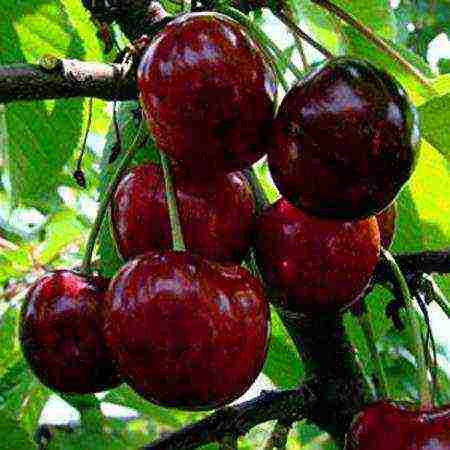
PROS:
- Self-fertile variety
- Fruits ripen early
- Taste and marketable qualities are excellent (the color of the berries is deep red, the pulp is moderately dense, tender, fleshy, it separates well from the stone)
- Large fruits, weight up to 6 g
- High productivity index
- Resistance to major diseases and garden pests is high
- Good frost resistance, up to - 28 degrees
MINUSES:
- There are no obvious shortcomings, based on the reviews of gardeners
Bakhor

PROS:
- The crop ripens early, in the first - in the second decade of May
- The tree grows very quickly, the degree of leafiness is medium, the crown is round
- Fruiting period begins in the fourth year after planting in a permanent place.
- The size of the fruits is quite large, 8-9 g, their color is dark red, wide-heart shaped
- The color of the pulp is dark red, the structure is medium density, very juicy, it has a sweet taste, there is a slight sourness
- The pulp separates well from the stone
- Due to the dense skin, the crop is not afraid of transportation over long distances, it retains its presentation for a long time
- The fruits can be used both for fresh use and for compotes, jams, preserves.
- Tasting score 5 points
- Dessert type harvest
- Planting material is grown from seedlings
- The indicator of resistance to fungal diseases is good
- Frost resistance is sufficient, up to - 25 degrees
MINUSES:
- Vigorous, height 5-6 m
- The yield indicator is average, up to 45 kg of fruits can be removed from one tree
Farewell
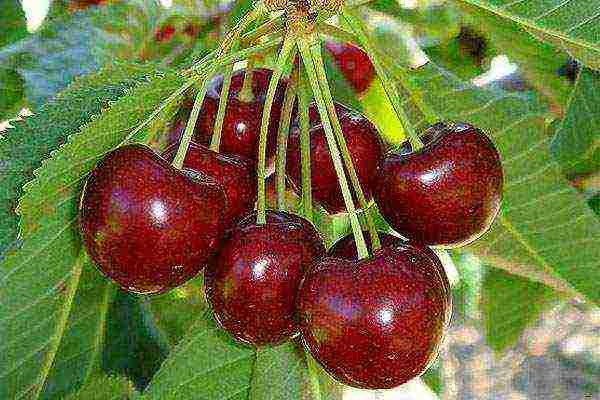
PROS:
- Cherries with early ripening, are very popular among gardeners and consumers.
- It is appreciated for its unpretentious care.
- Excellent taste of fruits, large-fruited, high rate of drought resistance and winter hardiness
- High yield rate, up to 95 kg of harvest is removed from one tree
- The fruits are excellent for fresh use, for winter harvesting
- The size of the berries is large enough, weight up to 13 g
- The color is red, the color of the flesh is yellow
- The taste is sweet, harmonious, the aroma is pronounced, there is a wine-sweet aftertaste
- The pulp is easily separated from the bone
- The tasting score is 4.5 points
- The variety is distinguished by its early maturity
- The yield is high, after 10 years the figure is about 100 kg
- Thanks to the dense skin, which protects the pulp well, the crop can be stored for a long time and is not afraid of transportation over long distances
- High degree of resistance to coccomycosis
- Increased degree of frost resistance
MINUSES:
- The tree is very vigorous, which makes it difficult to pick berries
- The variety is self-fertile, additional pollination is required.
- Average indicator of resistance to fungal infections
Pollinator varieties: Donetsk coal, Valery Chkalov, Donetsk beauty, Sister, Valeria, Donetsk Yaroslavna, Ethics, Rannnya rovinka, Aelita, Annushka, Donchanka
Yaroslavna

PROS:
- The tree is medium-sized, its height does not exceed 3.5 m
- Does not require special conditions for growing, care
- The yield indicator is high, annual
- Type of separation from the stalk dry
- Taste and marketable qualities are excellent
- Fruit size is large, weight is 8-9 g
- The pulp is very sweet, pleasant, of medium density, red in color
- The color of the cherry pomegranate is red, the stone is small in size, it separates well
- The increased degree of frost resistance, drought resistance, resistance to coccomycosis
- Berries in high humidity conditions do not crack
- Transportability is good
MINUSES:
- The variety is vigorous, the crown is spherical - spreading, the branches are curved
- Additional pollination required
- Average indicator of resistance to fungal infections
Pollinators: Ovstuzhenka, Raditsa, Iput, Chermashnaya, Fatezh.
7.5 Overall Score
After reviewing the description of cherry varieties, having studied their strengths and weaknesses, you can choose the most suitable option for your personal plot. It is recommended to purchase seedlings in specialized retail outlets, while you need to pay attention to the presence of damage on the trunk and root system. We tried to collect for you the most popular varieties of cherries and give all the necessary information on them. If you disagree with these ratings, leave your rating in the comments with the reasons for your choice. thank you for your participation. Your opinion will be useful to other users.
Add your review | Read reviews and comments
The best varieties of cherries are a conditional concept, since in warm regions - in Ukraine, in the south of Russia - more thermophilic plants are common, but residents of the Leningrad region and the Moscow region need to select frost-resistant varieties.
In addition, someone loves sweet, and someone with sourness; some are crispy and some are softer; there are adherents of black cherry varieties, pink, yellow, with a red barrel ... There are a great variety of sweet cherry varieties! How not to get lost among this variety and choose the best cherry variety just for you - we will figure it out in this article.
Cherry varieties: classifications
Classification of cherries by ripening dates
You can provide yourself with sweet juicy fruits for almost the entire summer - from late June to August. To do this, you need to create in your garden a collection of early-ripening cherry varieties (ripen around the end of June), mid-ripening (ripen around mid-July) and late-ripening varieties (ripening period - early August).
Early ripe cherry varieties - Iput, Gronkavaya, Early Rose, Valery Chkalov, Skazka, Chance, Ruby Early, Elektra, Ariadna, Chermashnaya;
Mid-season varieties of cherries - Tyutchevka, Leningradskaya rose, Rechitsa, Revna, Fatezh, in memory of Chernyshevsky, Ovstuzhenka, Orlovskaya Rose, Veda, Adeline, Poetry, Pink Pearl, Dniprovka, Dilemma;
Late-ripening cherry varieties - Prestige, Leningradskaya black, Red dense, Bryanskaya Pink, Orion, Romance, Lyubitsa Turovtseva.
Classification of cherries by fruit color
Black (dark red cherry): Veda, Adelina, Tyutchevka, Bryanochka, Revna, Raditsa, Leningradskaya Chornaya, Iput, Gronkavaya, Ariadna, Ovstuzhenka, Rechitsa, Michurinka;
Yellow cherry: Chermashnaya, Drogana yellow, Home garden yellow, Red dense (yellow cherry with a red barrel);
Pink cherries: Leningrad pink, Early pink, Oryol pink, Bryansk pink, Fatezh;
Orange Cherry: Pink Pearl;
Classification of cherry varieties by taste
Sweet cherries: Michurinskaya, Raditsa, Ovstuzhenka, Tyutchevka, Rechitsa, Leningradskaya black, Chermashnaya, Iput, Gronkavaya, Bryanskaya pink, Ariadna, Revna;
Sweet cherry with sourness: Early pink, Poetry, Oryol pink, Fatezh, Pink pearl.
Classification of cherries according to the structure of the pulp
Conventionally, according to the density of the pulp, the sweet cherry is divided into two groups - with tender, soft pulp (gini) or dense, crunchy (bigarro).
Gini cherry varieties: Early pink, Orlovskaya pink, Liningradskaya black, Leningradskaya pink, Chermashnaya, Iput;
Bigarro cherry varieties: Michurinka, Poetziya, Fatezh, Rechitsa, Bryanskaya rozovaya, Ariadna.
Description of varieties of sweet cherry with a photo
Description of cherry varieties with photos
Drogan yellow cherry variety
Drogan yellow cherry
Yellow Drogan yellow cherry is a mid-season frost-resistant variety of the bigarro group. The variety is highly adaptive, it can grow in Belarus, and in the North Caucasus, and in Central Asia. The fruits of the sweet cherry variety Drogana yellow are heart-shaped, weighing 6-7 grams, the pulp is light yellow, the juice is almost transparent.
Features of the Drogan yellow cherry variety: - Drogan's cherry tree, yellow, tall, with a spreading crown. Consider this if the site is small;
- very thin skin of the fruit. On the one hand, it is much more pleasant to eat berries with a delicate skin, on the other, such cherries are poorly suited for transportation or freezing, and the fruits can crack on the tree. The bone does not separate from the pulp;
- high productivity. Moreover, all the fruits reach at the same time, do not fall off on their own;
- high drought resistance and frost resistance;
- Drogana Yellow is not a self-pollinated variety, therefore, cherries of other varieties will need to be planted in the garden;
- susceptible to damage to the cherry fly.
Cherry variety Home Garden Yellow
Sweet cherry Home garden yellow
Cherry Priusadebnaya Zheltaya belongs to the early maturing varieties of the bigaro group. The average weight of one berry is 5-6 grams, the pulp and skin are yellow, the pulp is sweet with sourness. This variety is perfect for the conditions of central Russia. Loves black soil.
Features of the sweet cherry variety "Homestead yellow" - self-pollinated variety, that is, it can do without pollinating neighbors;
- begins to bear fruit quite late - in the 6th year (ordinary cherries - in the 4-5th year);
- extremely productive variety;
- despite the fact that the Homestead yellow is an early-ripening variety, it is not afraid of frost;
- not susceptible to fungal diseases or cherry fly damage;
- it reproduces very actively, therefore it will cause a lot of trouble with pruning and removing shoots. In addition, the crown of the tree is very lush.
Cherry variety Rechitsa
Cherry Rechitsa
Cherry Rechitsa belongs to the mid-season varieties of the bigarro group, sweet in taste, frost-resistant. The weight of the berries reaches 6 grams, the pulp is dark red, the stone is easily separated from the pulp. The tree itself is of medium height. Sweet cherry Rechitsa is relatively unpretentious to the soil, excellent for central Russia.
Features of the variety Rechitsa - berries are not prone to cracking;
- frost-resistant variety, not susceptible to diseases;
- pollinating trees are needed (Adelina, Ovstuzhenka, Pink Pearl);
- not a very prolific variety - one tree will yield no more than 15 kg of cherries.
Cherry variety Leningradskaya Black
Cherry Leningradskaya black
Leningradskaya black belongs to the mid-season varieties of the gini group. The berry tastes sweet, but not large - 3-4 grams, the bone does not separate from the pulp. The height of the tree is up to 3.5 meters.
Features of black Leningradskaya black cherry: - low winter hardiness;
- not capable of self-pollination (it is best to plant in a pair with the varieties Revna, Veda, Tyutchevka, Bryanochka, Iput);
- medium-fertile varieties - up to 20 kg of sweet cherries are harvested from one tree.
Cherry variety Ovstuzhenka
Cherry Ovstuzhenka
Cherry Ovstuzhenka belongs to mid-season varieties, berries weigh 6-7 grams, very juicy and sweet. The variety is suitable for cultivation in the south of the Non-Black Earth Region.
Features of sweet cherries Ovstuzhenka: - berries are not prone to cracking;
- the variety is frost-hardy enough, not susceptible to diseases;
- relatively low yield - no more than 15 kg from one tree;
- not capable of self-pollination (it is recommended to plant in tandem with Tyutchevka, Revna, Raditsa, Iput).
Cherry variety Leningradskaya pink
Sweet cherry Leningradskaya pink is a mid-season variety of the Gini group. The berries are small enough, about 3.5 grams, the pulp is very tender, yellowish, the skin is yellow with a ruddy side. Leningrad pink is suitable for growing in the northwestern and central Non-Black Earth Region.
Features of the Leningradskaya pink variety: - the tree is quite tall with a lush crown;
- not capable of self-pollination (it is recommended to plant in tandem with varieties of memory of Chernyshevsky, Pink Pearl, Rechitsa, Adeline);
- average yield - no more than 15 kg from one tree.
Cherry variety Tyutchevka
Cherry Tyutchevka
Cherry Tyutchevka belongs to mid-season varieties. Berries weighing about 5 grams, the stone is poorly separated from the pulp. The tree is of medium height, extremely resistant to disease and cold. Cherry varieties Tyutchevka are recommended to be grown in the south of the Non-Black Earth Region.
Features of cherry varieties Tyutchevka:
- average yield - up to 15 kg per tree;
- well suited for transportation or freezing;
- not capable of self-pollination (planted together with Ovstuzhenka, Iput, Raditsa).
Cherry varieties Revna
Cherry Revna
Cherry Revna belongs to mid-season varieties. The berry is dark red, almost black in color, weighs 4.5-5 grams, the bone is separated from the pulp well, the pulp is quite dense. The height of the tree is average. Cherry Revna feels good in the south and in the center of the Non-Black Earth Region of the Russian Federation.
Features of cherries Revna - partially self-fertile variety, but for abundant fruiting it is necessary to plant in a pair with Tyutchevka, Iput, Raditsa, Ovstuzhenka;
- winter-hardy variety, not susceptible to diseases;
- excellent for transportation and freezing;
- excellent, abundant fruiting - up to 30 kg of fruits from one tree.
Sweet cherry varieties Iput
Cherry Iput
Cherry Iput belongs to the early ripening varieties of the gini group. The fruit weighs 5-5.4 grams, the sweet pulp is difficult to separate from the stone. A medium-sized tree with a wide crown. Sweet cherry Iput is recommended for cultivation in the south and in the center of the Non-Black Earth Region.
Features of the Iput cherry variety:
- fantastic yield - up to 30 kg of fruits per tree;
- extreme frost resistance - can withstand up to -32 degrees of frost;
- resistant to fungal diseases;
- partially capable of self-pollination. For a regular and good harvest, you need to plant next to the cherries of the varieties Ovstuzhenka, Raditsa, Revna, Bryanskaya pink.
Sweet cherry varieties Fatezh
Cherry Fatezh
Cherry Fatezh belongs to the mid-season varieties of the Bigaro group. The berries weigh about 4.3 grams and are sweet and sour. A medium-sized tree with a spherical crown and beautiful drooping branches.Fatezh cherries are best grown in the south in the center of the Non-Black Earth Region.
Features of Fatezh cherries - the buds are not very frost-resistant, in contrast to the trunk and branches;
- the yield can reach 30 kg per tree;
- not susceptible to diseases, in particular - rot;
- a self-infertile variety, you should choose Ovstuzhenka, Iput, Raditsa as neighbors.
Sweet cherry varieties Bryansk pink
Sweet cherry Bryansk pink
Sweet cherry Bryanskaya pink refers to late-ripening varieties of the bigarro group. The berry weighs about 5 grams, the pulp is sweet, pink in color, the small stone does not separate from the pulp. Sweet cherry Bryanskaya pink feels good in the central part of the Non-Black Earth Region.
Features of the Bryansk pink variety: - the buds are not resistant to frost, and the trunk and skeletal branches are resistant;
- due to the peculiarities of the crown, the tree practically does not need pruning;
- high yield - up to 30 kg per tree4
- berries are not prone to cracking.
- not capable of self-pollination, Ovstuzhenka, Revna, Tyutchevka, Iput should be planted in the neighborhood.
Of course, this is not a complete list, but we have considered the most popular cherry varieties. We hope that the description of cherry varieties with a photo will help you make the right choice. We remind you: when choosing a cherry variety, be sure to ask whether it is self-fertile or not, and with which cherry varieties it should be planted. Only in this case you will get an excellent harvest of cherries, which we wish you with all our hearts!
Tatiana Kuzmenko, member of the editorial board Sobcor of the Internet edition “AtmAgro. Agroindustrial Bulletin "
Sweet cherry is one of the most popular garden crops for growing on a personal plot. The yield and taste of berries largely depends on the choice of varieties for a particular region. Today, dozens of different varieties of this culture have been bred, with their own advantages and disadvantages. In the article we will consider the best varieties of cherries for central Russia, describe the features and photos of berries.
What to consider when choosing a cherry variety?

When choosing a cherry variety for central Russia, many factors must be considered:
- You should pay attention to winter hardiness. Sweet cherry is a thermophilic plant that can die during frosts. The higher the frost resistance of the variety, the better.
- It is advisable to purchase low-growing varieties - they have a more productive yield in an unfavorable climate, since most of the nutrients are spent on the formation of berries, and not on the crown.
- It is recommended to choose varieties that have a late flowering period - in conditions of middle latitudes, there is a protracted spring and a late onset of stable high temperatures.
- Self-fertile varieties that do not need cross-pollination with other members of the species are best suited.
The best varieties
Breeders have bred several dozen varieties and hybrids of sweet cherries with different characteristics, productivity and adaptive abilities. Consider the descriptions of varieties for cultivation in the middle latitudes of Russia.
Iput
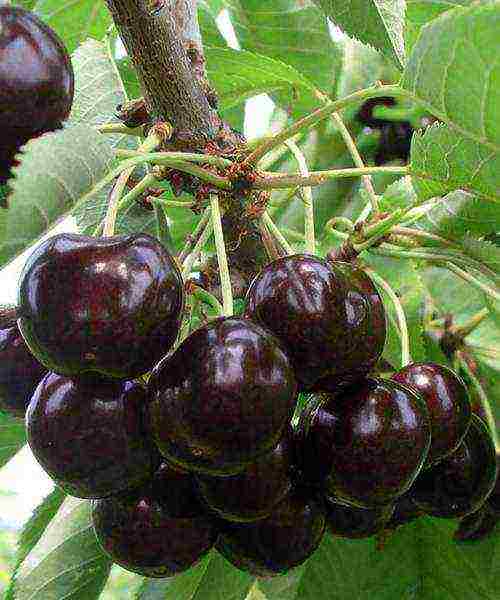
A fast-growing sweet cherry variety, bred by domestic breeders at the Research Institute of Lupine. It has been used for cultivation since 1993. The tree is medium-sized, reaching 4-5 meters in height.
The crown is dense, has a pyramidal shape, the leaves are elongated, elliptical with pronounced serration. The petioles are thick and short, on which there are 3-4 large flowers with white petals.
Flowering begins in May, the first harvest can be taken by mid-June. Fruits are large, blunt, heart-shaped, weighing up to 6.3 g. The skin is glossy, colored dark red. The pulp is juicy and tender, has a sweet dessert taste. The variety is versatile in application. Average productivity is 25-30 kg / tree.
The variety is winter-hardy, resistant to fungal diseases. Self-infertile type of pollination.
Jealous

A mid-late variety, bred at the Research Institute of Lupine by crossing seedlings of Bryanka pink cherry with other species. Recommended for cultivation in the Central Region.
Medium-sized trees with a pyramidal crown. Begins fruiting from 5 years. In spring, many ovoid leaves with jagged edges are formed on the shoots. The petiole has embossed veins and is colored brownish-pink. Flowering begins in mid-May, fruits ripen from early June. The variety is partially self-fertile, the proportion of self-pollination does not exceed 5%.
The fruits are of medium size, have a flat-round shape and an average weight of 4.7 g. The skin is very dense, dark red in color. The pulp is red in color, has a dense consistency and dessert taste, a medium-sized pit. The variety has high indicators of transportability.
Winter hardiness is above average, there is resistance to temperature extremes and sunburn. There is a high resistance to fungal diseases.
Fatezh

A mid-early variety bred at the All-Russian Institute of Selection and Technology by free pollination of Leningradskaya yellow sweet cherry. Listed in 2001, suitable for cultivation in the Central Region.
The trees are medium-sized with a height of up to 5 m. The crown is spherical, spreading and of medium density. The leaves are lanceolate, have finely serrated serration. White flowers, fruit ovaries are formed both on bouquet branches and annual shoots.
Flowering begins in late May, fruits are formed from the second decade of June. The berries are rounded, weighing up to 4.4 grams. The pulp is light yellow in color, with a juicy and dense structure. The stone is light, medium in size, well separated during processing. The taste is dessert type, has a sweet and sour aroma. The variety has a high yield - up to 30 kg / tree.
Winter hardiness is above average, there is no susceptibility to diseases. There is immunity to fungal diseases. The cultivar is self-fertile. The main disadvantage is the tendency to gum flow.
Tyutchevka

Late ripening variety, bred in 2001 at the Research Institute of Lupine by crossing Red dense cherry.
The tree is of medium height and fast growth rate. The crown is rare, spherical, depending on the place of cultivation, it can be spreading or semi-spreading. The leaves are large in size with a strongly pointed tip.
Fruiting occurs on bouquet branches. Flowering begins by mid-summer, fruiting by late July or early August.
Large fruits have a spherical shape and an average weight of 5.3 grams. The skin is dark red, small specks are acceptable. The pulp is red, with a dense and cartilaginous structure. The berries have a sweet taste with a high tasting rating. The maximum productivity occurs after 4-5 years of growth, the yield is up to 40 kg / tree.
It has a high level of winter hardiness and resistance to fungal diseases. The variety is sterile, the quality of self-pollination does not exceed 6%. The main disadvantage is the cracking of the fruit in humid climates.
Bryansk pink
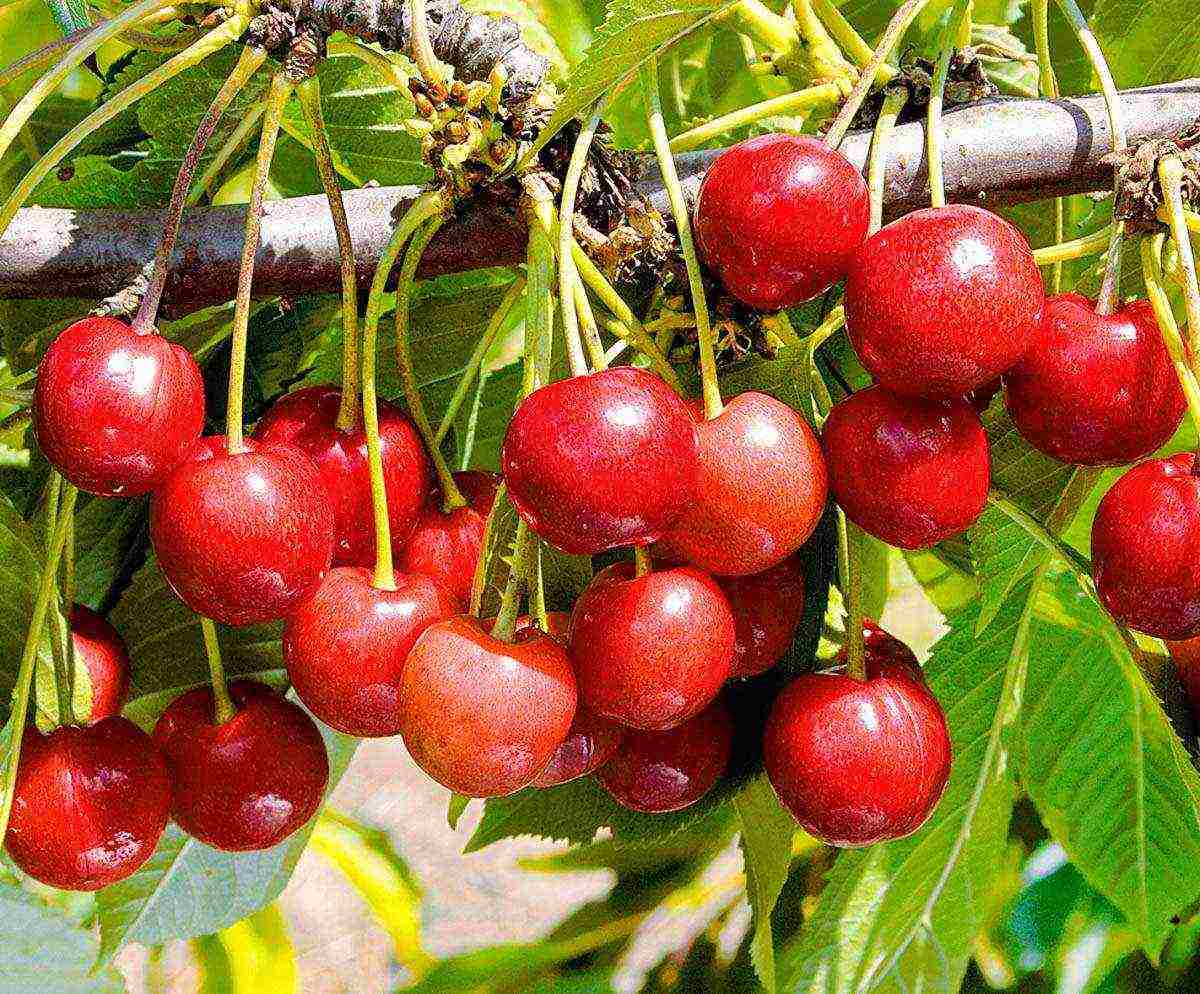
A late-ripening variety bred at the Research Institute of Lupine in 1987. Obtained on the basis of crossing cherry seedlings of the Black Muscat variety (Negritenok).
Sweet cherry is represented by a medium-sized tree with a raised pyramidal crown. The leaves are large, have a pointed top and a double-serrate serration. Fruits are formed on bouquet branches and annual shoots.
Flowering begins in mid-May, ripening of fruits - from the second decade of July to early August. Fruits are medium in size, round in shape. Average weight - 4.0 g. The skin is dense, pink-yellow in color. The pulp is of a dense, cartilaginous consistency, with decent taste characteristics. The variety has universal application, the fruits tolerate transportation well. Productivity - up to 30 kg / tree.
The stem and base of the tree has a high winter hardiness.There is a high immunity to fungal diseases of stone fruits. The variety is self-fertile, resistant to cracking.
Crimean

The variety was bred by domestic breeders in the Tula region, little is known about the history of its origin. In middle latitudes, it is used relatively rarely due to the presence of more productive crop varieties.
The tree reaches 3.5 m in height, is of medium size and spherical in shape. The berries ripen early, starting in mid-June. Fruits are small up to 2 g, have a dark red color. The pulp is juicy and tart; due to its specific taste, it is often used for making wine and compotes. Productivity - up to 7.5 kg / tree.
Crimean cherry is winter-hardy and is often used not for harvesting, but as a pollinator for other fruitful varieties.
Oryol pink

The variety was bred in 1999 by domestic breeders by free pollination of the Narodnaya sweet cherry. Recommended for growing in mid-latitudes.
The tree has an average vigor, its height reaches 3.5 m. The crown is pyramidal, slightly raised. Flowering begins in the second decade of May, the fruits ripen by mid-July. Fruiting occurs on fruit twigs and last year's shoots.
The berries are round, weighing up to 4 g. The skin is dense, pink in color. Inside there is a pinkish pulp with medium density. The stone is large, up to 4.5% of the weight of the fetus, it separates well. Dessert variety, received average tasting ratings.
The variety is self-fertile, has a high winter hardiness. Resistance to fungal diseases of stone fruit crops is relatively low. Productivity from a tree - up to 42 kg.
Narodnaya Syubarova
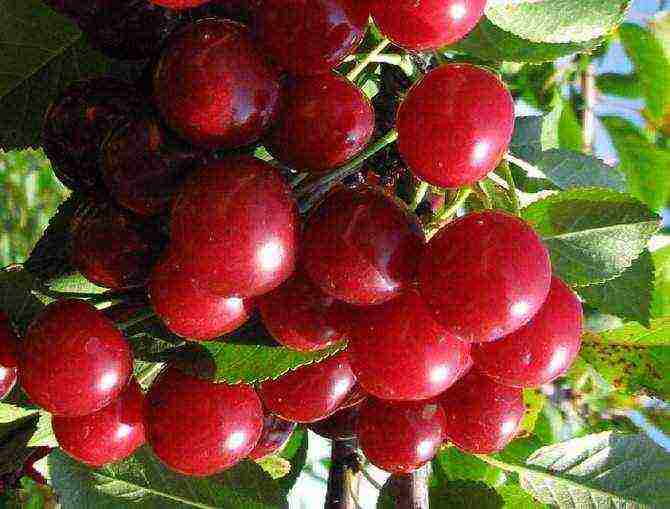
The variety was bred in Belarus by the famous breeder E.P. Syubarova. It is considered one of the best for growing in mid-latitudes and central regions of Russia.
The tree is strong and tall, due to which the resistance to wind and snow load increases, the branches are well developed. Saplings take root in any soil, even in marginal loam and sandy loam soil. The variety is completely self-fertile, does not need other pollinators. Begins fruiting in 3 years, the berries are formed by the second decade of July.
Fruits are medium in size, weighing up to 6 g. The skin has a deep red color, pronounced shine. The pulp is red, juicy and tender. Received high tasting marks. The stone is small, well separated from the pulp.
The variety is winter-hardy, withstands severe frosts. Resistant to most typical diseases, cracking of fruits is not observed in hot seasons. Productivity - up to 50 kg / tree.
Ovstuzhenka
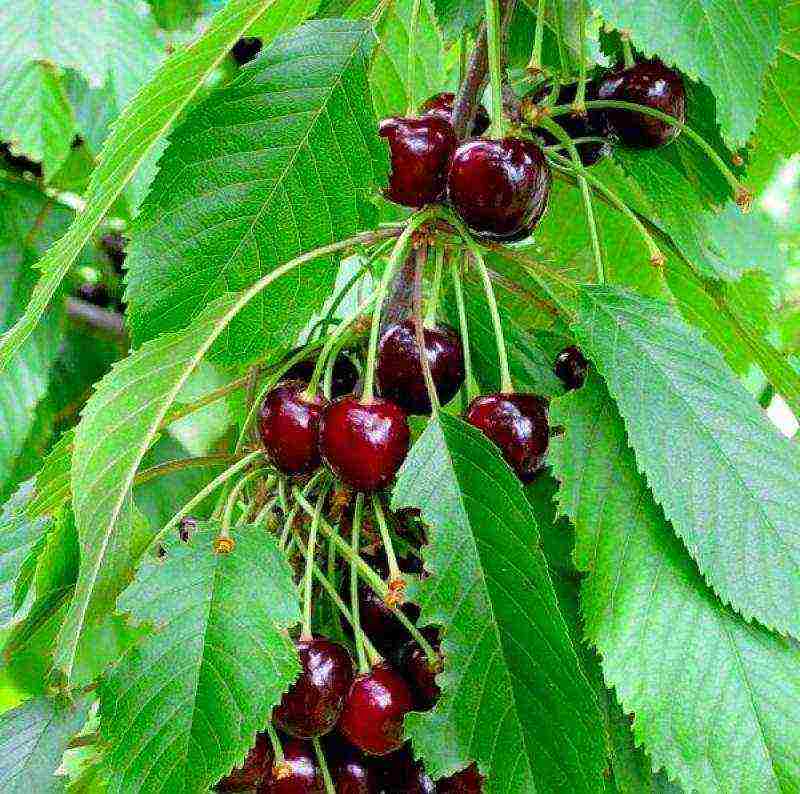
The variety was bred in 2001 at the Research Institute of Lupine using the hybridization of cherries of the Leningradskaya Black and Compact Venyaminova varieties. Suitable for cultivation in the southern and central regions, high yield indicators have been identified in the black earth regions.
The tree is small in size but grows quickly. The crown is raised, spherical in shape. The leaf blade is ovate with double-serrate serration. Ovaries are formed only on bouquet branches.
Large fruits can reach a weight of up to 6 g, the shape is oval or round. The skin is dense and shiny, has a dark red tint. The stone is small, easily detached. The pulp is deep red in color, has a sweet taste and a high tasting rating. Withstands transportation well, the variety has a universal purpose. The maximum yield is 30 kg / tree.
High rates of winter hardiness are observed, immunity to fungal diseases of stone fruit crops is developed. Low self-pollination, it is necessary to have other varieties nearby.
Gronkovaya
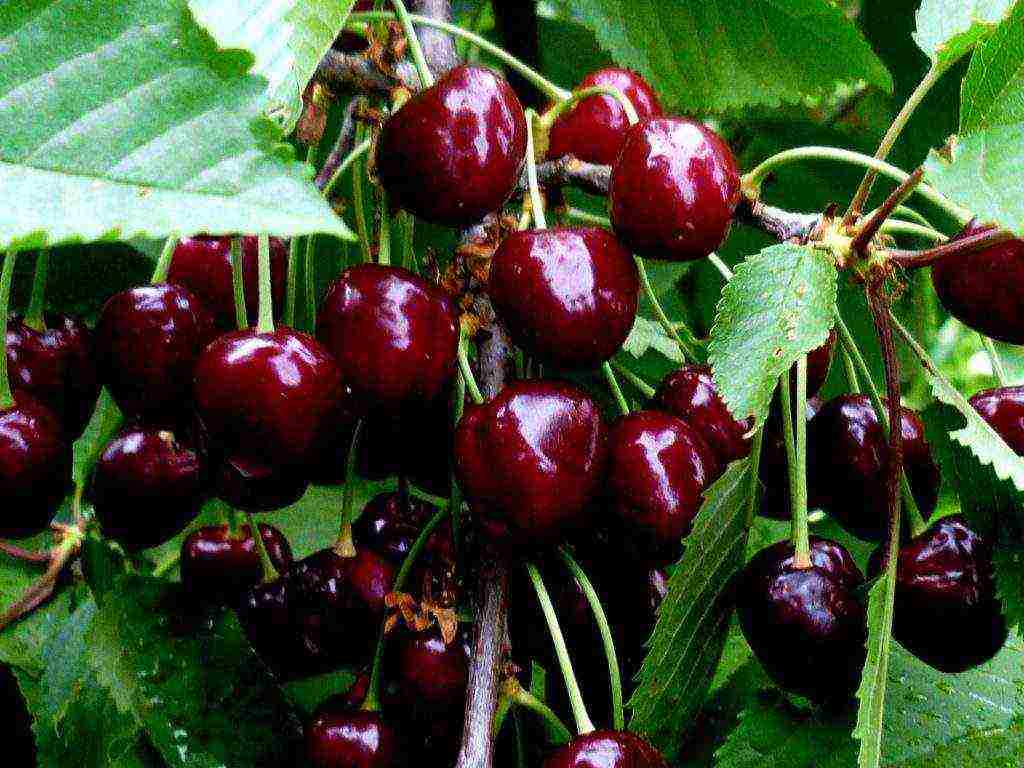
The variety was obtained by free pollination by Belarusian breeders in 1999. Widely distributed in the North Caucasian region and the Astrakhan region.
Sweet cherry is represented by a medium-sized tree with a wide-pyramidal crown.During planting, it is recommended to increase the space between the trees to avoid darkening. Fruiting begins in 3-4 years, harvesting is possible from the end of June.
The berries are even heart-shaped, the average weight of the fruits is 4-5 g. The skin is dark red in color with a pronounced waxy bloom. The pulp is rich red, medium density. The peduncle and stone are easily separated. The taste of the fruit is sweet and has average tasting ratings. Sweet cherries for universal use.
The variety is characterized by increased resistance to frost and disease. The tree is self-fertile, planting of pollinators is required. The yield is high - up to 20 kg / tree.
Backyard yellow
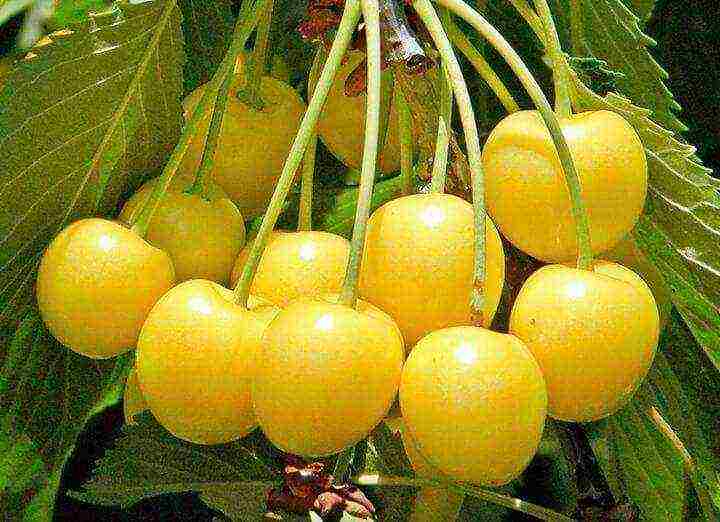
A variety of early ripening, bred at the Research Institute of Genetics and Breeding. IV Michurina in 1998 by crossing the Leningradskaya red and Zolotaya Loshinskaya cherries. Recommended for cultivation in the Central Region.
A fast-growing tree with a spherical crown of medium density. The leaf is large, has an oval-conical shape and a concave plate. Begins fruiting from the 6th year of life.
The fruits have an oval shape and a wide funnel, the average weight is 5.5 g. The skin is yellow without integumentary points. The pulp is juicy, gives an almost colorless juice. The berries have received high tasting ratings and are used for table purposes.
The variety is self-fertile, has a high frost resistance. The fruits do not crack in humid climates, have an attractive appearance and good transportability.
Red hill

Bred at the Research Institute of Lupine under the guidance of the famous breeder M.V. Kanshina. Successfully passed field trials for cultivation in the Central Region.
The tree is weak, reaching a height of up to 3 meters, the most active growth is observed in the first year of life. The crown is dense, ovoid. Leaves are oval in shape, have a pointed end. Fruit formation occurs on fruit and growth shoots. Flowering begins in early May, fruiting - in the second decade of June.
The berries have a traditional heart-shaped shape, the average weight is 5-6 g. The color of the skin is golden with a pronounced red blush. The pulp is devoid of pigment, the stone is well separated during processing. Application - table, fruits received high tasting marks.
The cultivar is self-fertile. Possesses high immunity and winter hardiness. The yield is high - up to 45 kg / tree. The main disadvantage is poor transportability and short storage time.
Rechitsa
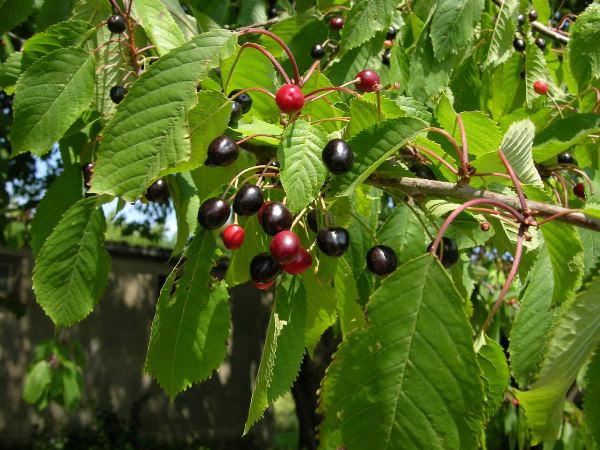
The variety was obtained on the basis of marker characters when growing sweet cherries Bryanskaya rozovaya. The development was carried out at the Research Institute of Lupine. Included in the official register in 2001.
The tree is fast growing. The crown is pyramidal, medium density. The leaf plate is green in color, has the shape of an ellipse. Fruiting is observed only on bouquet branches; it begins to bear fruit from the 5th year of life. Average ripening and flowering period.
The berries are round in shape, can reach a weight of up to 4.9 g. The color of the skin is almost dark red, almost black. The pulp is dense, inside which there is an oval bone. The berries are juicy and sweet to taste, universal use. Productivity up to 23 kg / tree.
Winter hardiness is high, there is resistance to characteristic fungal and infectious diseases of stone fruits. The variety is self-fertile, pollinators are required.
Leningradskaya
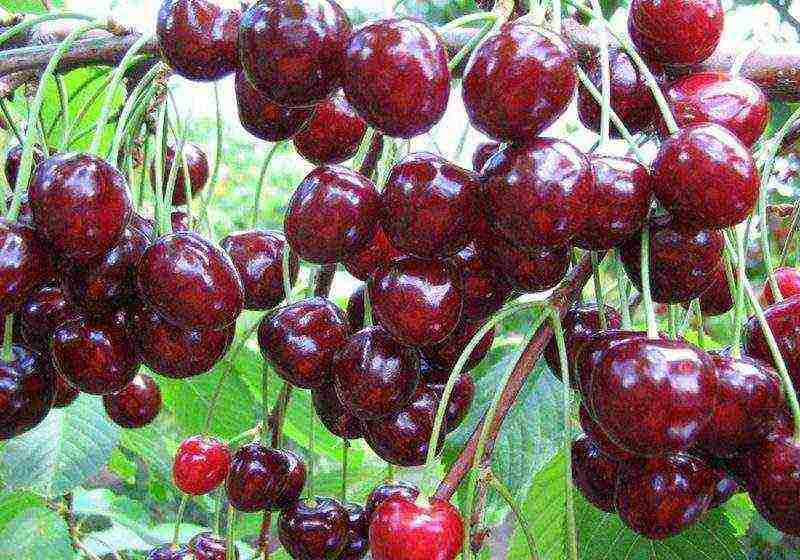
An early ripening variety bred at the Pavlovsk experimental station of the VIR. It is one of the first varieties of sweet cherry with high winter hardiness.
The trees are medium-sized, up to 4 meters high. Crohn's medium, wide pyramidal shape. Active fruiting begins at 3-4 years of age. In the conditions of the middle latitudes of Russia, ripening is observed from the second decade of July.
The berries are round in shape, weighing up to 3.5 g. The skin is almost black in color and has a pronounced gloss. The pulp is fibrous, tender and juicy in taste. Tasting ratings are average, often used for preparing drinks.
The variety is extremely frost-resistant.Fruit shedding is extremely rare, in combination with a high yield (up to 40 kg / tree), it is one of the best varieties for the Central regions of Russia.
Large-fruited
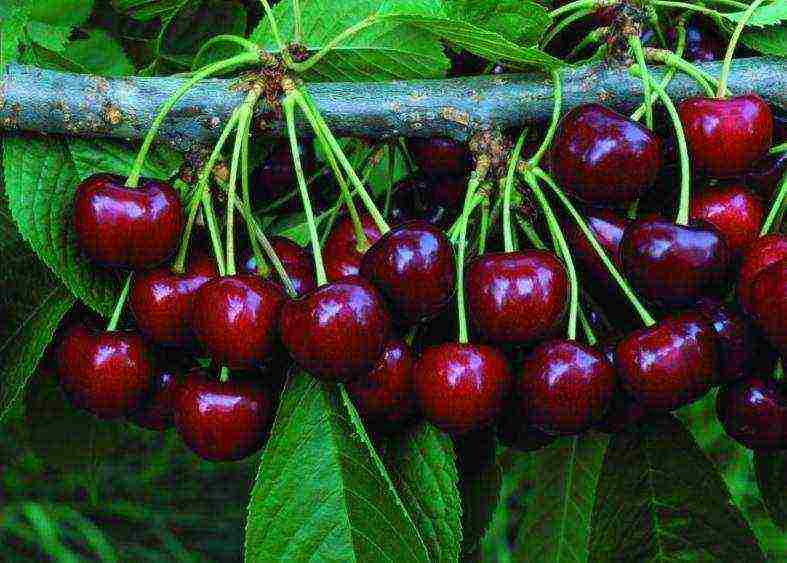
Bred in the 80s of the last century by Ukrainian breeders by pollination of a number of sweet cherry varieties. The fruits have received awards at various exhibitions several times.
The tree shows rapid growth at a height of 4-5 m. The crown is spherical with an average volume of foliage. The leaf plate is strongly elongated, has a pointed top. Fruits are formed on bouquet branches and last year's shoots. Begins fruiting from 4 years old. Late ripening period.
The berries are very large, they can weigh up to 13 g. They have a rounded shape and a dark red skin color. The pulp is dense, has medium cartilage. Taste - sweet and sour, average tasting ratings are obtained. The stone is large, but easily separated from the fetus. The type of application is universal.
This variety is often used for fresh sale as it has a long shelf life. Cracking of the crop is possible during wet seasons. Sweet cherry has a weak resistance to bacterial diseases, the indicators of frost resistance are high.
Michurinka
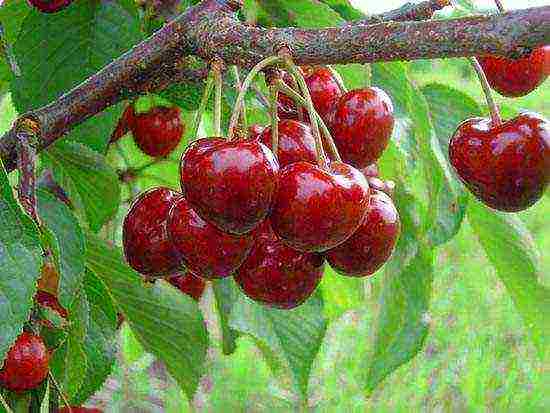
A hybrid variety obtained by employees of the N.N. Michurina by crossing Leningradskaya yellow cherries.
The tree is of medium height. The crown is oval, less often rounded. The leaf is in the form of an ellipse, there are no stipules, a strongly pointed tip is often formed. Begins fruiting after 5 years, late ripening of berries.
The fruits have an average weight of up to 4.7 g, heart-shaped. The color of the skin and pulp is dark red, the stalk is medium in size. The pulp is quite dense, inside which there is a large bone. The berries are sweet in taste and retain their presentation for a long time.
There is a relatively high resistance to fungal diseases and frost. The type of application is universal, often used for fresh consumption.
Italian
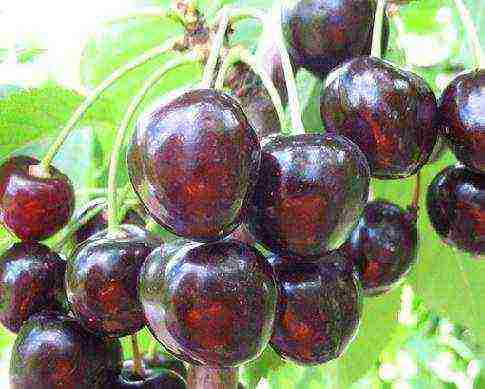
A variety of early ripening, bred by specialists from the N.I. Michurin by crossing the Bigarro and Slava Zhukov cherries. Field tested in 1995.
The tree is of medium vigor. The crown is pyramidal, the flowers are large and white. It begins to bear fruit in 4-5 years after planting.
The berries are large, the average weight is 6 g. The fruits are dark red, the skin has a waxy coating. The pulp has a pleasant taste and dense texture. Quite high tasting marks were obtained. The sweet cherry is easily separated from the stalk, does not crumble during the harvest period.
The variety is known for its high yield, it has resistance to a number of fungal diseases. Average frost resistance, used for fresh consumption and for the preparation of juices and preparations.
Lena

Hybrid variety of late ripening, obtained from sweet cherry Bryanskaya rozovaya. The development was carried out at the Research Institute of Lupine. All tests were passed in 2006.
The tree shows average growth rates, height up to 4 m. The root is oval, has an average density. The variety is self-fertile, fruiting occurs 4 years after planting on bouquet branches.
The berries are heart-shaped, the average weight is 6 g. The color of the skin is black-red, with a slight waxy bloom. The pulp has a sweet and sour taste, high tasting ratings. Recommended for fresh consumption, however, the type of application is universal.
Productivity is maintained only for 7 years, then it is necessary to vaccinate or transplant. There is resistance to fungal diseases and frost.
Sadko
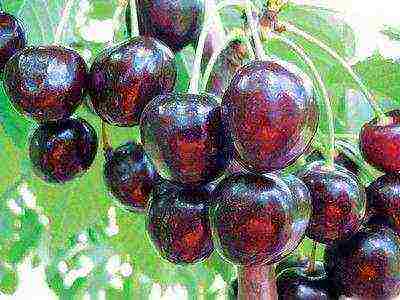
An early ripening variety obtained at the Research Institute of Lupine by crossing several hybrid varieties of sweet cherries. Tested in 2005 in the Central region of Russia.
The tree has medium growth characteristics. The stem is prone to peeling, the crown is rounded. Fruiting is observed starting from 4 years after planting. Berries are formed on fruit branches and bouquet branches.
The fruits weigh up to 6.1 g, the shape is oval. The skin is colored dark red, possibly with small specks. The pulp is red in color, has a dense consistency and a pleasant taste. Resistance to fruit cracking is noted.
The Sadko variety has a high winter hardiness, but the pistils are susceptible to frost. Relatively high characteristics of immunity to fungal infections. Self-fertile type of pollination, good yield indicators.
Today there are dozens of names of sweet cherry varieties for cultivation in the middle regions of Russia. When choosing a plant for your garden, you should consider not only resistance to frost and disease, but also taste characteristics, as well as yield indicators. The taste and quantity of fruits depends a lot on the right care and climate in your area.
Many people love sweet cherry, so it is grown everywhere in gardens and summer cottages. The culture is not picky, but it will not tolerate neglect. She needs regular watering, pruning, feeding, and sometimes insulation for the winter. Early varieties of cherries: white and red, fruitful and large-fruited will be described below in the article.
What are the features of early cherry varieties?
Early varieties of cherries are the most famous and popular trees for planting, because they give early harvests. Early fruiting makes life easier for the gardener - you can quickly make preparations for the winter, sell a lot more berries, and also eat plenty of cherries and replenish the supply of vitamins for the coming months!
But besides the ripening period, are there any common characteristics in the early varieties of sweet cherries? There is one common similarity that every gardener should be aware of. Usually, all such trees need a pollinator tree to grow nearby. Without it, there will be either very little or no fruit.
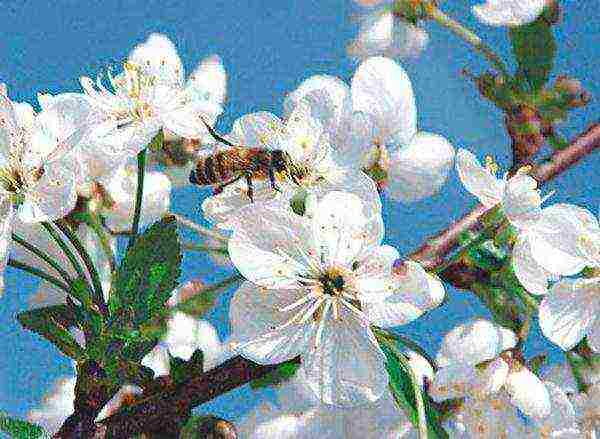
It is necessary that a pollinator tree grows nearby
Otherwise, these species are too diverse: color, berry size, yield, type of cultivation and characteristics they may be completely different. It is possible, perhaps, to note the endurance to return cold, but not all gardeners will agree with this, because it is the early varieties of cherries (flowers and buds on them) that often freeze out during spring frosts.
What early varieties of sweet cherries have high yields?
Productivity is the first thing that is important if early cherry varieties are planted for a large family, with an abundance of relatives and friends, or for sale. In these cases, 20-30 kg of yield from one tree is not enough, so it is worth choosing more productive varieties of early cherries.
- "Household" annually produces up to 85 kg of berries from a tree. Fruiting begins from 5-6 years, berries ripen from the beginning of June. The tree grows up to 4 meters, the crown is not very thickened, round. Berries up to 5.5 grams, with tender, creamy pulp. The color of the berries is yellow, with a rich red blush. High transportability. Pollinators: Vinka, Skorospelka, Valery Chkalov.
- "Iput" can provide a family with 60-80 kg of cherries per tree in one season. Her berries are not very large, the weight rarely reaches 8 grams, the color is burgundy, the shape is heart-shaped. Fruiting from the 5th year, but large yields should be expected only from 7-8 years, not earlier. The crop is harvested from mid-June. Cherries of the varieties "Ovstuzhenka", "Bryanskaya rozovaya", "Tyutchevka", "Raditsa", "Revna" are suitable for her as pollinators. A tree with a wide crown grows.

Early varieties of sweet cherries with high yields
- Valery Chkalov - an early variety of sweet cherry, has a yield of up to 60 kg / tree and gives large berries weighing 7-9 grams each. The shape is rounded, the color is burgundy, and when overripe is almost black. Ripening has been observed since the beginning of June. The taste is sweet, the tasting score is 4.5 points. Resistance to mild moderate temperatures and some diseases is observed. The best pollinators include: "Skorospelka", "Zhabule", "June early".
- "Melitopol early" gives 50-60 kg of berries from each tree. Berries 6-7 grams, oval, dark red. The pulp is dense, juicy, sweet, the aroma is strongly pronounced. The stone is large, it separates from the pulp without problems. The use is universal. Pollinators: Valery Chkalov, Ruby Early, Bigaro Burlat.
- "Leningradskaya black" gives 40 kg of harvest per tree annually. Fruiting in 3-4 years, the harvest ripens around the beginning of July. The tree is tall with a massive crown. Differs in cold resistance. Fruits up to 5 grams, sweet, juicy, ovoid, slightly flattened. The color is dark scarlet. The taste is bright, full-bodied with a honey flavor. Most often used for processing for the winter. Cherries "Veda", "Revna", "Tyutchevka", "Michurinka" are planted nearby as pollinators.
- "Maiskaya" - an early variety of sweet cherry, has an average yield of 40 kg per tree. Fruiting from 4 years old, the crop is usually harvested from late May or early June. The berries can be said to be small, since their weight ranges from 2 to 4 grams. The color is bright red. A feature of the variety can be called resistance to frost and disease. It is used exclusively for fresh consumption and desserts, because in conservation the variety completely loses its taste, there is neither sweetness nor aroma. Poorly transported. Pollinators can be: "Dzherelo", "Early Duki", "Melitopol early".
Large varieties of cherries
Early varieties of sweet cherries can be roughly divided into small-fruited, medium and large-fruited. Of course, the latter are the most convenient for eating and processing. Also, it is the large varieties of cherries that attract buyers in the market and in stores, and they can be sold at a higher price.
- "Farewell" has a yield of 60 kg per tree annually with good care. The tree is of medium height, the crown is spreading, with an abundance of foliage. Fruiting from 4-5 years, fruit ripening - mid-June. The berries are dense, large - 14 grams, dark red. Sweet wine taste, strong aroma. High transportability. Pollinators: "Donetsk beauty", "Donetsk coal".
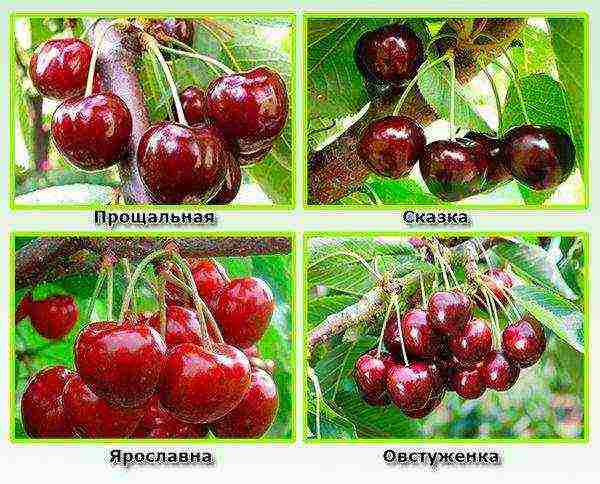
Large varieties of early cherries
- "Story" it is valued precisely for its large berries (10-12 g) and a pleasant, sweet taste, although the pulp is moderately juicy. The cherry color is scarlet, the shape of the berries is almost round. Fruiting begins from the 5th year, and the annual harvest ripens from the beginning of June. Pollinators include: "Ovstuzhenka", "Tyutchevka" and "Iput". Resistance to transportation, frost and berry cracking is noted.
- "Yaroslavna" - an early variety of sweet cherries, has rather large berries up to 9 g each. The bone is small, it can be separated without any problems. The tree grows tall, the crown is massive. Differs in good frost resistance. The yield is 20-30 kg per tree every year. Ideal for juicing. Fruiting from the beginning of July. Pollinators: Annushka, Donetsk Beauty, Valeria.
- "Ovstuzhenka" - a small tree with a not wide crown and an abundance of leaves. Cherries 4-6 g, burgundy. A pleasant feature of the variety is that the stone is separated without problems. Productivity 25-35 kg annually. Ripens from the second half of June, and fruiting is observed only from 4-5 years. Sweet cherries-pollinators: Tyutchevka, Revna, Iput, Bryansk pink, Pink pearl.
Early varieties of yellow cherries
Early varieties of sweet cherries with yellow berries are not very expensive on the market, as they quickly deteriorate. But if you grow them in your own garden, you can get not only good berries for conservation, but also an abundance of vitamins, because yellow cherries are very useful for the body.
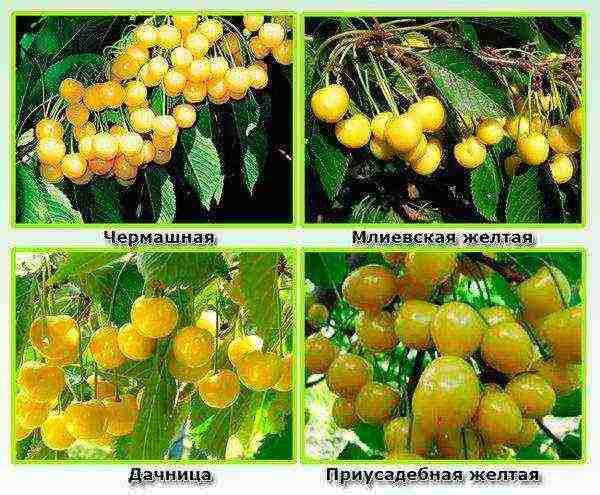
Early varieties of yellow cherries
- "Chermashnaya" has a tall tree with a thickened, elongated crown. Berries up to 5 grams are yellow, ripen from the beginning of June. The pulp is fleshy, with a high proportion of juice and a honey aftertaste. The bone is separated without problems, which makes processing easier. Diseases and frosts are easily tolerated. Pollinators: "Iput", "Bryansk pink", "Fatezh", "Leningradskaya black".
- "Mlievskaya yellow" - an early sweet cherry variety, ripening from mid-June. Berries 5-6 grams, yellow, with shiny skin. The main difference with this variety is that it does not require pollinators.Average winter hardiness. The first fruiting can be expected for 4-5 years. Suitable for processing and fresh consumption.
- "Summer resident" ripens from mid-June. The berries are light yellow, weighing 7-11 g, heart-shaped. The stone separates well from the pulp. Fruiting in 4 years. The tree grows low, the crown is spreading. Pollinators: "Talisman", "Yellow Drogana", "Melitopolskaya".
VIDEO - Very tasty cherries "Priusadebnaya"

